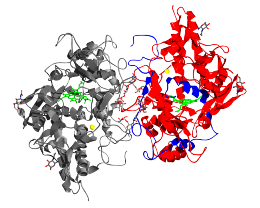Structural and functional characterisation of a novel bacterial peroxidase with homology to human heme peroxidases
SUPERVISOR: CHRISTIAN OBINGER
Project assigned to: ANDREA NICOLUSSI
Background.
Peroxidases are heme containing oxidoreductases, which are able to catalyze the one- and/or two-electron oxidation of various organic or inorganic substrates with hydrogen peroxide. Several heme peroxidase superfamilies and families have evolved independently in evolution. In this work the first representatives of a novel bacterial peroxidase family from the peroxidase-cyclooxygenase superfamily will be investigated. Interestingly, these prokaryotic oxidoreductases are homologous to mammalian peroxidases (myeloperoxidase, eosinophil peroxidase, lactoperoxidase and thyroid peroxidase) that are important players in the innate immune system and in hormone biosynthesis. These peroxidases are able to catalyze the two-electron oxidation of halides (chloride, bromide, iodide) or thiocyanate thereby producing the corresponding antimicrobial hypohalous acids or hypothiocyanite.
Before organisms have developed an acquired immune system, their defense might have depended on enzymes like peroxidases that are recruited upon pathogen attack and produce halogenating and oxidizing agents in order to kill invading pathogens. The presence of homologous peroxidases in bacteria could imply that these activities were already necessary in early stages of evolution, presumably as a defense system of bacteria against other bacteria or simple eukaryotes. The aim of this project is to investigate the structure-function relationships of these novel bacterial metalloproteins in comparison with their well-studied mammalian counterparts.

Aims and methods.
The aim of the thesis is to elucidate structure-function relationships of selected representatives of this new bacterial peroxidase. In the beginning the respective enzyme from the nitrogen-fixing cyanobacterium Lyngbya PCC 8106 will be heterologously expressed in E. coli and investigated by a broad set of biochemical and biophysical techniques including X-ray crystallography, mutational analysis, sequential-mixing stopped flow spectroscopy, electronic circular dichroism spectrometry, electronic paramagnetic spectroscopy, resonance Raman spectroscopy and mass spectrometry.
We aim at (i) studying the nature and impact of heme to protein linkages on the spectral and redox properties as well as on the individual reaction steps within the catalytic cycles, (ii) to identify the site(s) of binding and oxidation of two-electron donors (halides, thiocyanate) and one-electron donors, (iii) characterize the reaction products, (iv) elucidate the high resolution structure of this oxidoreductase in complex with various (pseudo-)substrates and in higher oxidation states and, finally, (v) compare the obtained data with those from the well studied mammalian counterparts
Auer, M., Gruber, C., Bellei, M., Pirker, K.F., Zamocky, M., Kroiss, D., Teufer, S.A., Hofbauer, S., Soudi, M., Battistuzzi, G., Furtmüller, P.G., Obinger, C. (2013) A Stable Bacterial Peroxidase with Novel Halogenating Activity and an Autocatalytically Linked Heme Prosthetic Group. The Journal of Biological Chemistry, 288, 27181-27199.
